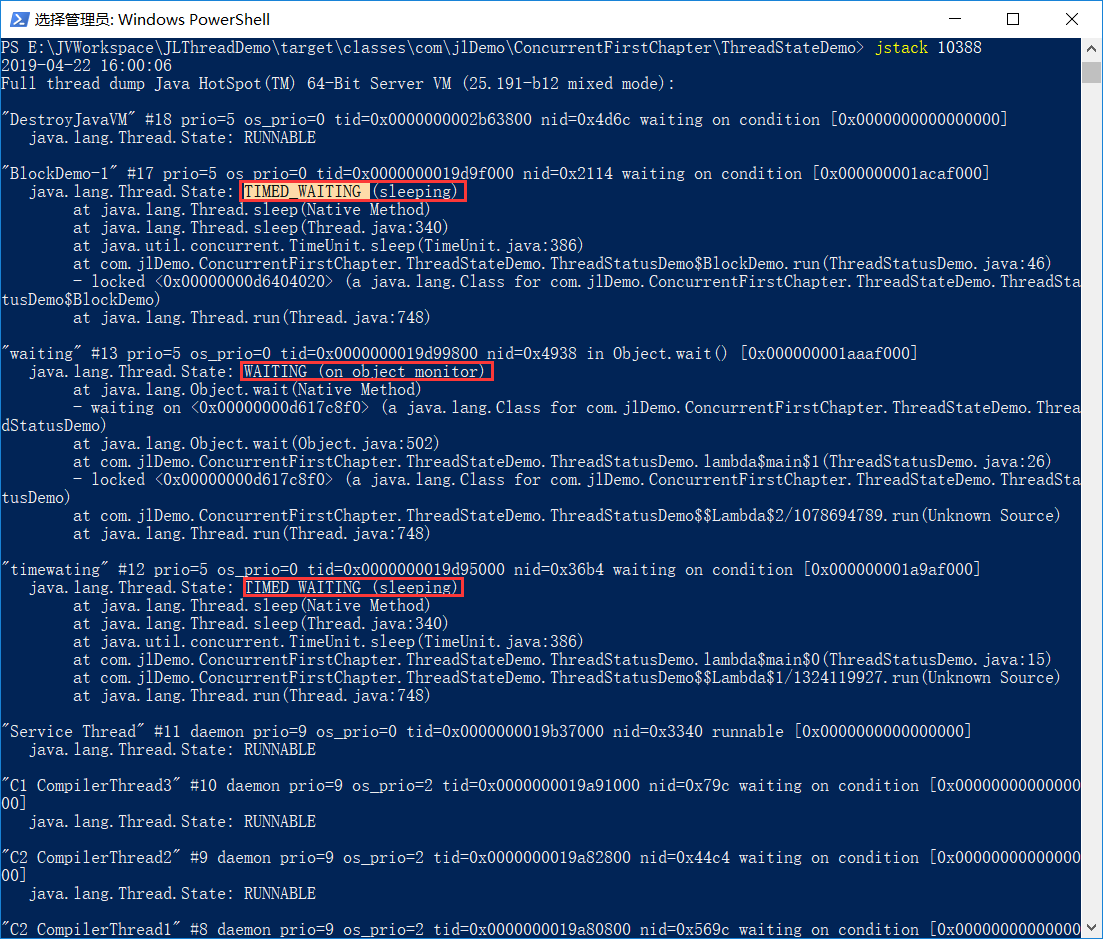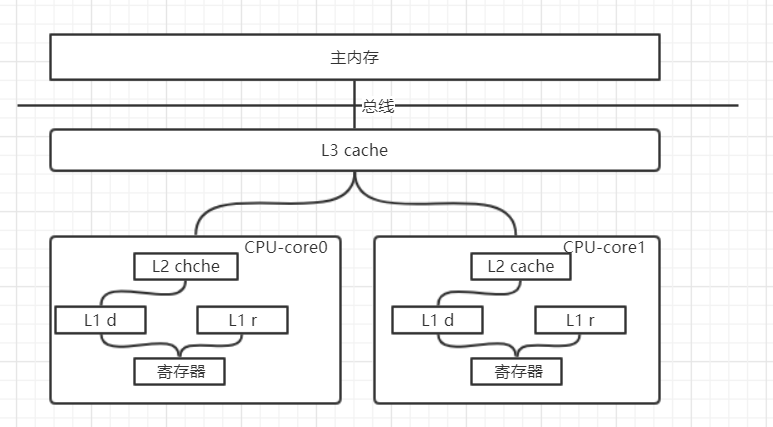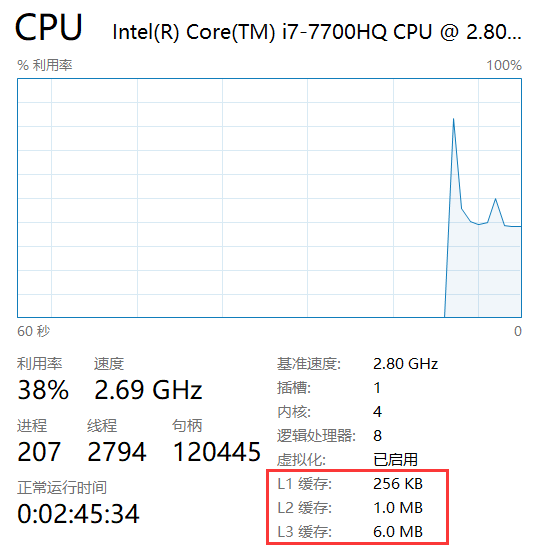多线程基础
1、多线程是怎么来的?
1.计算机资源的利用不充分。
2.批处理操作系统。--指令有阻塞,指令都在同一块内存中。
3.进程的出现。--让指令得以切换或者说让CPU时间片得以切换。分配单独的内存地址。
4.线程的出现。将一个进程中的多个子任务放在线程中进行处理。多核CPU可以实现并行。
2、多线程的应用场景?
1.通过并行计算提高程序性能
2.等待网络、IO响应导致的耗时问题。例如将BIO的处理放在线程池中进行处理,从而实现其他程序能够异步执行。
3.Thread 如何应用在项目中。代码示例:

1 package com.jlDemo.ConcurrentFirstChapter.ThreadDemo; 2 3 /** 4 * @author jar luo 5 * @time 2019.4.22 6 */ 7 public class Request { 8 private String name; 9 10 public String getName() { 11 return name; 12 } 13 14 public void setName(String name) { 15 this.name = name; 16 } 17 18 @Override 19 public String toString() { 20 return "Request{" + 21 "name='" + name + '\'' + 22 '}'; 23 } 24 } 25 26 package com.jlDemo.ConcurrentFirstChapter.ThreadDemo; 27 /** 28 * @author jar luo 29 * 30 * @time 2019.4.22 31 */ 32 public interface RequestProcessor { 33 34 void processorRequest(Request request); 35 36 } 37 38 39 package com.jlDemo.ConcurrentFirstChapter.ThreadDemo; 40 41 import java.util.concurrent.LinkedBlockingQueue; 42 43 /** 44 * @author jar luo 45 * @time 2019.4.22 46 * @desc 打印请求的内容--借鉴zk的责任链思想 47 */ 48 public class PrintProcesser extends Thread implements RequestProcessor { 49 50 LinkedBlockingQueue<Request> linkedBlockingQueue = new LinkedBlockingQueue(); 51 52 private final RequestProcessor nextProcessor; 53 54 public PrintProcesser(RequestProcessor nextProcessor) { 55 this.nextProcessor = nextProcessor; 56 } 57 58 @Override 59 public void run() { 60 while (true){ 61 try { 62 Request request = linkedBlockingQueue.take(); 63 System.out.println("print data:" + request); 64 nextProcessor.processorRequest(request); 65 } catch (InterruptedException e) { 66 e.printStackTrace(); 67 } 68 } 69 } 70 71 @Override 72 public void processorRequest(Request request) { 73 linkedBlockingQueue.add(request); 74 } 75 } 76 77 78 package com.jlDemo.ConcurrentFirstChapter.ThreadDemo; 79 80 import java.util.concurrent.LinkedBlockingQueue; 81 82 /** 83 * 84 */ 85 public class SaveProcessor extends Thread implements RequestProcessor{ 86 87 LinkedBlockingQueue<Request> linkedBlockingQueue = new LinkedBlockingQueue(); 88 89 90 @Override 91 public void run() { 92 while (true){ 93 try { 94 Request request = linkedBlockingQueue.take(); 95 System.out.println("save data:" + request); 96 } catch (InterruptedException e) { 97 e.printStackTrace(); 98 } 99 } 100 } 101 102 @Override 103 public void processorRequest(Request request) { 104 linkedBlockingQueue.add(request); 105 } 106 } 107 108 109 package com.jlDemo.ConcurrentFirstChapter.ThreadDemo; 110 111 /** 112 * 113 */ 114 public class Demo { 115 116 PrintProcesser printProcesser ; 117 118 public Demo() { 119 SaveProcessor saveProcessor = new SaveProcessor(); 120 saveProcessor.start(); 121 printProcesser = new PrintProcesser(saveProcessor); 122 printProcesser.start(); 123 } 124 125 126 127 public static void main(String[] args) { 128 Request request = new Request(); 129 request.setName("jar luo"); 130 new Demo().doTest(request); 131 } 132 133 public void doTest(Request request){ 134 printProcesser.processorRequest(request); 135 } 136 137 138 }
3、并发编程的基础知识?
1.Thread
2.Runnable
3.Callable。 代码示例:

1 package com.jlDemo.ConcurrentFirstChapter.CallableDemo; 2 3 import java.util.concurrent.*; 4 5 /** 6 * @author jar luo 7 * 8 * @desc 并发编程(一)--Callable 9 * 10 */ 11 public class CallableDemo implements Callable<String> { 12 13 public static void main(String[] args) throws ExecutionException, InterruptedException { 14 ExecutorService executorService = Executors.newCachedThreadPool(); 15 CallableDemo callableDemo = new CallableDemo(); 16 17 Future<String> future = executorService.submit(callableDemo); 18 19 String str = future.get();//阻塞 20 System.out.println(str); 21 22 executorService.shutdown(); 23 24 25 } 26 27 @Override 28 public String call() throws Exception { 29 // 30 return "string" + 1; 31 } 32 }
4.Future
5.线程的状态 6种
NEW 没有调用start()方法,初始状态
RUNNABLE 运行状态
BLOCKED 阻塞
等待阻塞 wait
同步阻塞 synchronize
其他阻塞 sleep/join/
WAITING 等待
TIMED_WAITING 时间等待
TERMINATED 终止
状态关系图图例:

代码示例:

package com.jlDemo.ConcurrentFirstChapter.ThreadStatusDemo; import java.util.concurrent.TimeUnit; /** * @author jar luo * @time 2019.4.22 */ public class ThreadStatusDemo { public static void main(String[] args) { new Thread(()->{ while(true){ try { TimeUnit.SECONDS.sleep(100); } catch (InterruptedException e) { e.printStackTrace(); } } },"timewating").start(); new Thread(()->{ while(true){ synchronized(ThreadStatusDemo.class){ try { ThreadStatusDemo.class.wait(); } catch (InterruptedException e) { e.printStackTrace(); } } } },"waiting").start(); new Thread(new BlockDemo(),"BlockDemo-0").start(); //第一次跑时BlockDemo-0 没有显示 new Thread(new BlockDemo(),"BlockDemo-1").start(); } static class BlockDemo extends Thread{ @Override public void run() { synchronized(BlockDemo.class){ try { TimeUnit.SECONDS.sleep(100); } catch (InterruptedException e) { e.printStackTrace(); } } } } }


6.线程的启动和终止
线程的启动 : 调用start 方法,是本地方法 native
线程的终止:
X:不使用过期的stop方法,相当于linux系统中kill一个进程,是一个暴力中断的方式,不知道是否有用户正在请求或者使用该线程,会导致数据异常或者一些不可预测的问题发生。
Y:a.使用interrupt方法 优雅的中断方式,先阻止新的请求进来,然后等正在处理的请求处理完成,然后在终止该线程;
Thread.interrupted 对设置的中断标识的线程进行复位. 可以恢复为false/
b.通过指令的方式 volite boolean isStop = false.
代码示例:

package com.jlDemo.ConcurrentFirstChapter.InterruptDemo; import java.util.concurrent.TimeUnit; public class InterupptDemo { private static int i; public static void main(String[] args) throws InterruptedException { Thread thread = new Thread(()->{ while(!Thread.currentThread().isInterrupted()){ i++; } System.out.println(i); },"interruptDemo"); thread.start(); TimeUnit.SECONDS.sleep(1); thread.interrupt(); //设置interrupt标识为true, 可以去jdk中查看本地方法源码 System.out.println(thread.isInterrupted()); } }

1 package com.jlDemo.ConcurrentFirstChapter.InterruptDemo; 2 3 import java.util.concurrent.TimeUnit; 4 5 public class ThreadInterruptedDemo { 6 public static void main(String[] args) throws InterruptedException { 7 Thread thread = new Thread(()->{ 8 while(true){ 9 boolean in = Thread.currentThread().isInterrupted(); 10 if(in){ 11 System.out.println("before:"+in); 12 Thread.interrupted();//设置复位 13 System.out.println("after:"+Thread.currentThread().isInterrupted()); 14 } 15 } 16 }); 17 18 thread.start(); 19 TimeUnit.SECONDS.sleep(1); 20 thread.interrupt(); 21 } 22 23 }
4、线程安全的问题?
可见性 volatile 关键字
原子性 没有办法在多线程情况下实现一个原子递增的问题
有序性 问题 程序运行的顺序和我们编写代码的顺序可能是不一致的,因为存在编译器的优化和指令的优化(CPU运行中的一个优化过程,指令重排序导致的执行乱序),不影响代码语义的情况下做的指令重排序.
硬件层面产生线程安全问题的原因:
由CPU的高速缓存和多核CPU技术的出现引发的缓存一致性问题。
JMM涉及的内容,线程是CPU的最小调度单元。
UML图例:(现代操作系统物理架构:)

本地电脑图示:
L1 分为 指令缓存 数据缓存

缓存一致性问题:通过在(处理器-> 高速缓存-> 缓存一致性协议->主内存)高速缓存和主内存之间架设缓存一致性协议来解决。
总线锁:(排它锁),会导致性能问题,相当于一个悲观锁。降低了CPU的利用率。
缓存锁:(MESI协议),只锁当前缓存,会加#Lock指令,使其他缓存失效。
标记位:
M(Modify):修改状态、
I(Invalid):失效状态、直接去主内存加载
E(Exclusive):独占缓存、只会在一个cou中使用,并且该cpu值和主内存中的值保持一致。
S(Shared):多核CPU缓存一致,实现共享 嗅探协议。
以上情况为硬件层面的问题,但是硬件和硬件之间操作系统的差异,从而迫使我们在软件层面进行进一步处理。这就要说说我们下一节的主角 JMM内存模型。
